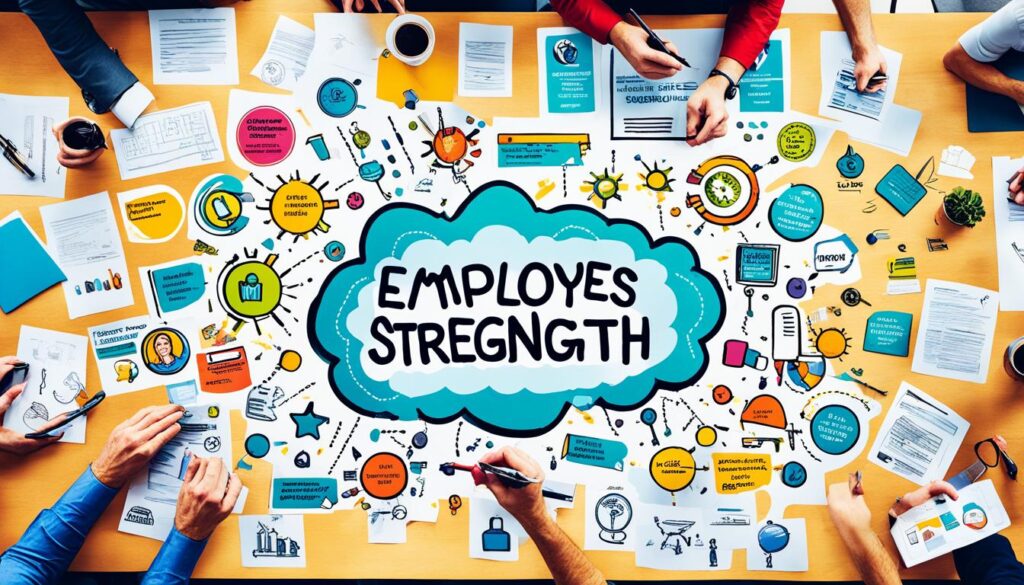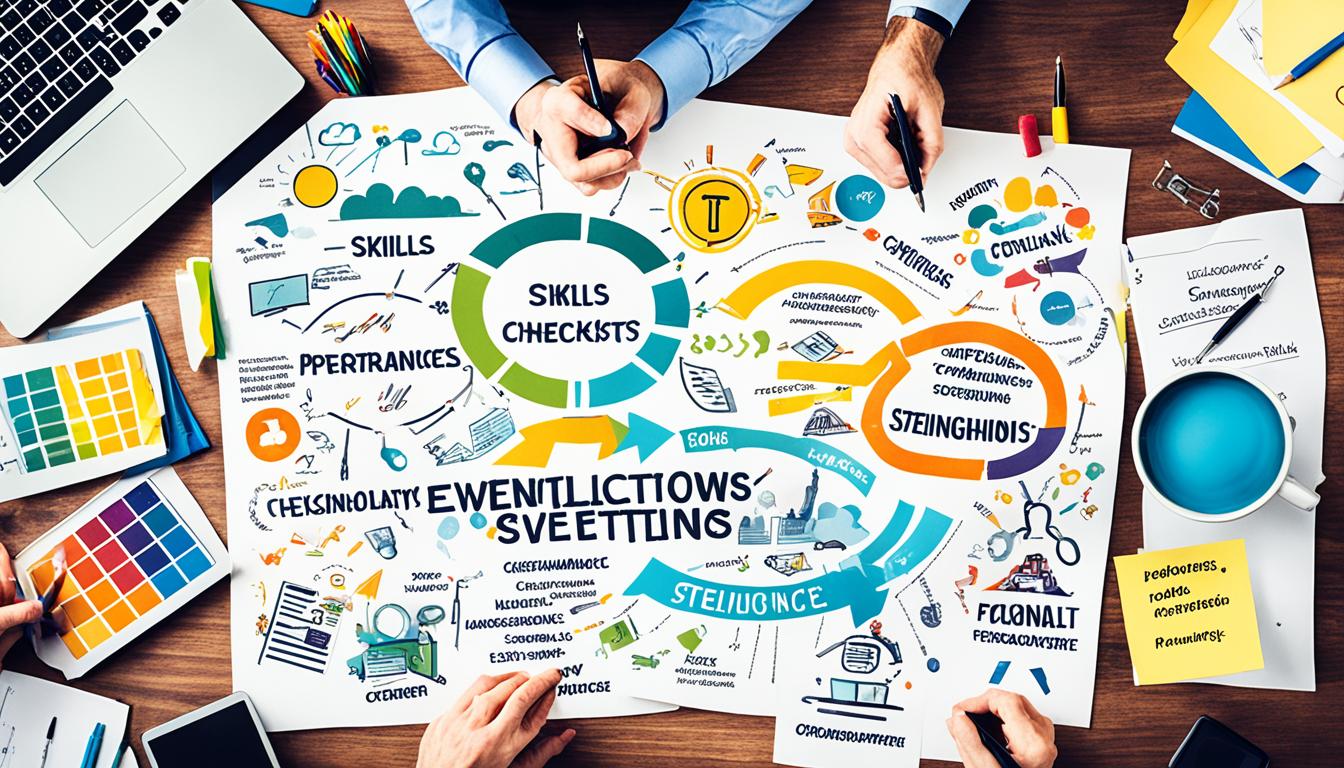Do you know workers who use their strengths a lot are 6 times more likely to love their job? It’s vital to spot and help employees use what they’re good at. This makes work better and helps it grow. Employers wonder, how do we know what our team is best at? We’ll look at ways to uncover these skills. This will let companies get the best from their people.
Key Takeaways:
- Knowing and boosting what employees are good at can boost their love for their job and how much they do.
- Employee strengths are more than just skills for a job. They are traits like talking well and solving problems.
- Ways to find out what employees excel at include them thinking about it, getting feedback, and tests to figure out skills.
- After finding these strengths, you can make them even better with training, mentors, and chances that use their strengths.
- Having a place where these abilities are seen and liked is crucial for people’s improvement and winning.
What are Employee Strengths?
Employee strengths are the special qualities individuals bring to their jobs. They’re more than just what you put on your resume. Every worker has their own mix of talents and traits. These make them valuable to their team. When we use and develop these strengths, it makes any group stronger and more able to face challenges.
Developing Unique Qualities, Skills, and Abilities
No one’s strengths are set in stone. They can be learned and improved. As people work and learn more, they pick up new skills and grow. It’s really important for companies to be places that help people learn and get better. This way, everyone can make the most of their unique abilities.
Companies help by offering classes and chances to learn. They also connect workers with mentors to guide them. Supporting employees to grow their skills helps make the workplace more diverse. It also promotes new ideas and strong teamwork.
Knowing and using what employees are good at is key to success. Their different skills and talents work together to solve hard problems, create new things, and do amazing work.
Going Beyond Job-Specific Skills
Employee strengths aren’t just about what someone needs for their job. They cover a lot of skills and abilities that help the whole organization. These strengths can show up in many ways.
- Effective communication: The ability to convey ideas clearly, listen actively, and collaborate with others.
- Adaptability: The agility to navigate change, embrace new technology, and thrive in dynamic environments.
- Problem-solving skills: The capacity to identify issues, analyze data, and generate innovative solutions.
- Leadership abilities: The aptitude to inspire, motivate, and guide others towards achieving common goals.
When companies recognize and use these strengths, their teams work better together. They encourage everyone to grow and do their best.
Key Strengths of an Employee
Understanding each employee’s key strengths is vital for team success. These strengths are not just about their skills for the job. They can also make a big difference in how well the whole organization does. By knowing and using these strengths, a workplace can become better at working together, coming up with new ideas, and achieving goals.
One major strength is the ability to talk well and clearly. It’s important for getting along with coworkers, clients, and others outside the company. Good communication helps everyone work together better, get more done, and make sure they understand each other.
Adaptability is also crucial in today’s work world. Things change fast, and being able to quickly adjust and find new ways to handle problems is a great skill. Adaptable employees help the team keep moving forward, even when faced with challenges.
Solving problems is another important strength. When employees can look at difficult issues and come up with solutions, it helps the whole organization do better and work more smoothly. Being good at figuring out problems, looking at different answers, and choosing the best one is a key asset.
Having leadership skills is a big plus too. Leaders, no matter if they have an official title or not, can inspire and encourage others. They help drive new ideas, steer the team through hard times, and get everyone to work toward common goals. Their leadership can lift the whole team to greater achievements.
There are many other strengths employees can have, like being a good team player, managing time well, thinking creatively, and understanding others’ feelings. These qualities make the work environment more positive and help people work together smoothly.

It’s key to notice and use these strengths to make a company succeed. If employers help their team use and build on their strengths, the entire workplace becomes more innovative and productive.
Now that we understand employee strengths, in the next section, we’ll explore how to find out what these are, along with areas where they might need improvement.
How to Identify Employee Strengths and Weaknesses
Knowing the strengths and weaknesses of your team is key to making them perform better. It helps you support them properly and find chances for them to grow. You can find out what your team is good at and where they need to improve.
Encouraging Self-Reflection
Ask your team to think about their skills and the things they’ve achieved. Also, where they need to get better. This helps people understand what they can do and how they can improve.
Revisiting Role Responsibilities
Check what each team member does in their job to know their skills and what they need to work on. Look at how they meet the job’s needs and find areas to improve. This gives a clear picture of their abilities.
Providing Feedback and Evaluation Opportunities
It’s important to give feedback about their work often. Let them know what they do well and how they could do better. This way, they can see how to improve their skills.
Identifying and Reviewing Patterns
Look for trends in how your team performs to see what they’re really good at or what they struggle with. Patterns can show you where someone’s strengths or weaknesses lie. This helps in focusing on areas that need development.
Utilizing Skills Assessments or Aptitude Tests
Tests and skill assessments can give you solid info on your team’s strengths and where they could do better. These tests measure how well they do in certain areas. You can use this info to plan their training and growth.
360-Degree Feedback
Ask for feedback from all around – from team members, bosses, and even those you manage. This gives a complete picture of their strengths and what they need to work on. Seen from all sides, you’ll get a better idea of their performance.
By using these methods, companies can understand their team better. This helps in making plans that are just right for each employee, such as personalized training or mentorship. With these plans, people and teams can reach their full potential.

How Can Tools and Resources Help in Implementing a Strengths-Based Approach in My Company?
Implementing a strengths-based approach in your company can be significantly enhanced by utilizing the right tools and resources. By providing employees with training programs and assessment tools, you create an environment focused on embracing strengths in your workplace, fostering collaboration and boosting overall morale and productivity. Additionally, integrating regular feedback mechanisms and recognizing individual and team achievements can further solidify this approach. By aligning your strategies with strengthsbased culture principles, you empower employees to leverage their unique talents while promoting a sense of ownership and accountability. Ultimately, this creates a thriving workplace where everyone feels valued and engaged, leading to sustained business success.
Growing Employee Strengths
Finding and helping employees with their strengths is key. To do this, companies must use smart ways to help them improve constantly.
Companies should give access to tools, courses, and workshops that fit each person’s talents. This way, employees get to enhance their skills and learn new ones. It helps them do better in their jobs and helps the company succeed.
Having someone more experienced as a mentor or coach can also be a big help. Mentors guide employees and give them useful advice. This support creates a good environment for learning and growing.
Projects that use what employees are good at can really push them to do their best. It makes work more fulfilling. Plus, it helps them get better at what they do.
Telling employees what they’re doing well is very important. This makes them feel good and want to keep getting better. It’s a big motivator for them.
Employers should aim to be a place where employees are supported and praised for their strengths. This way, employees can grow a lot. In such a workplace, both the employees and the company can flourish.
FAQ
What are some employee strengths assessment tools?
Many tools are available for assessing employee strengths today. Some top choices are Gallup’s CliftonStrengths, the Myers-Briggs Type Indicator (MBTI), and DISC. These instruments help employers spot and grasp what makes each worker unique.
How can I identify employee strengths?
There are several ways to figure out what your employees are good at. You can ask them to think about their own strengths. Also, looking at their job duties and past reviews can give you clues. Collecting feedback from others in the workplace through 360-degree reviews is also really insightful.
What are some key strengths of an employee?
Good communication, the ability to adapt, and solve problems stand out as critical strengths. So do leadership skills that can really drive a company forward. Teamwork, managing time well, being creative, and emotionally intelligent are all significant too.
How can I identify employee weaknesses?
Spotting where employees might struggle is important. You can do this by offering regular feedback and assessments. It’s also key to talk openly with them. This can shed light on areas needing growth.
How can I support the growth of employee strengths?
To help employees get better at what they’re already good at, try a few strategies. Offer them training and workshops that match their strengths. Having mentors around can be a big plus too. Encouraging them to take on projects that let them shine is also a good idea. And remember, feedback and pat on the backs work wonders.


